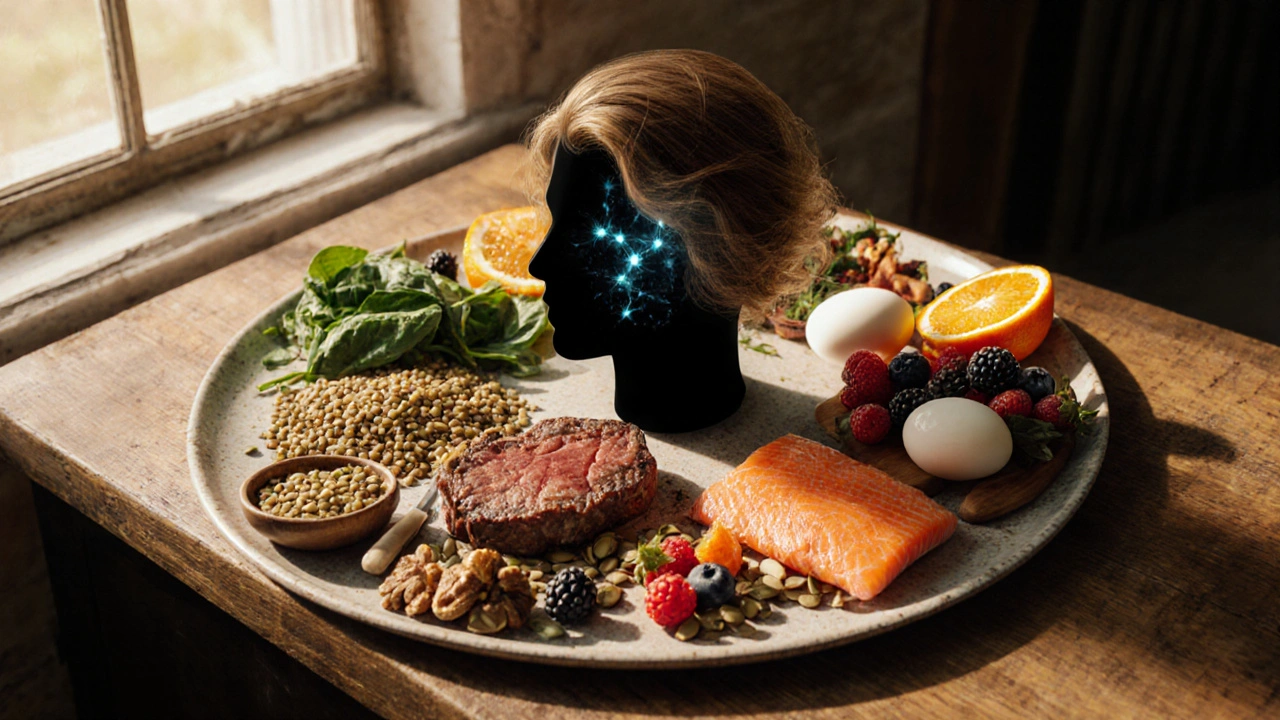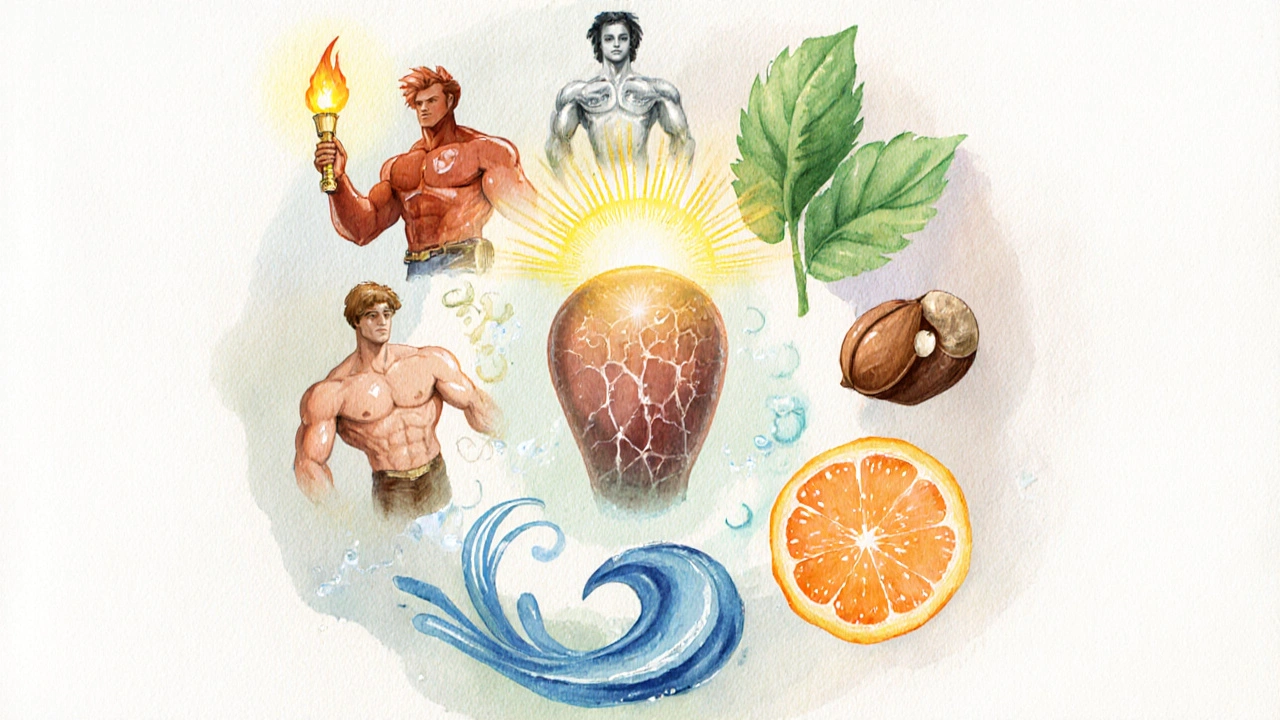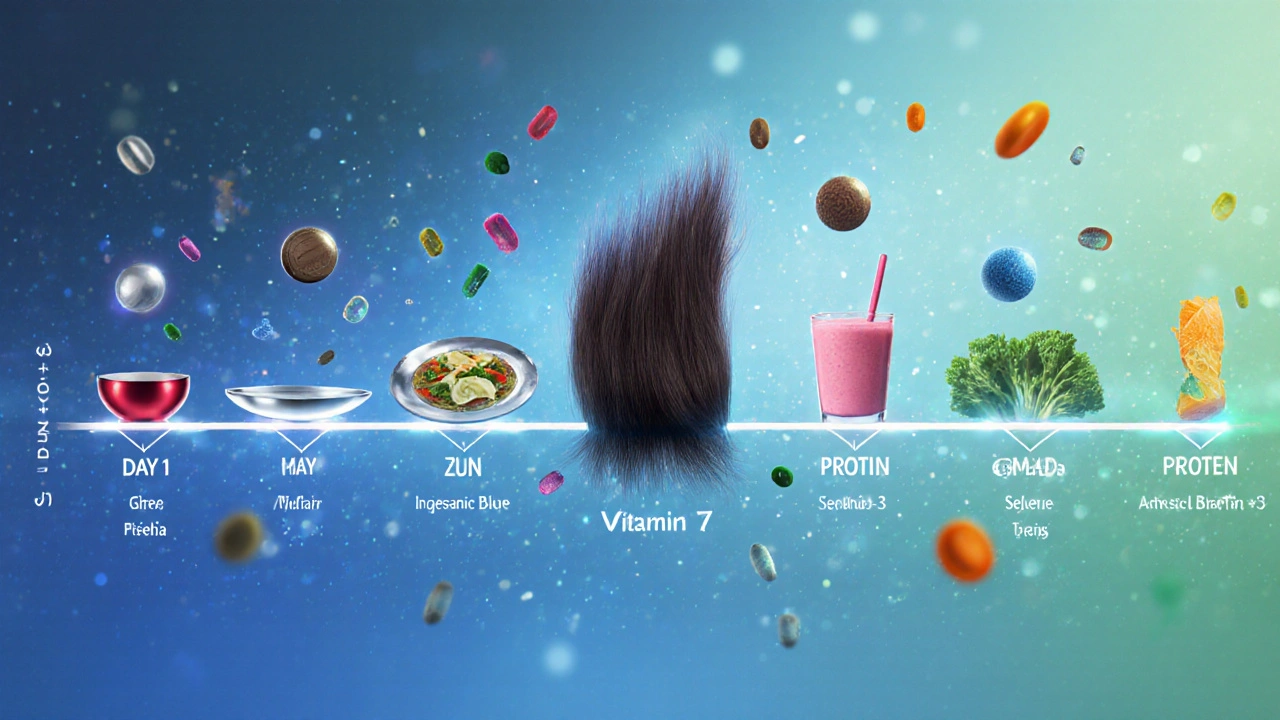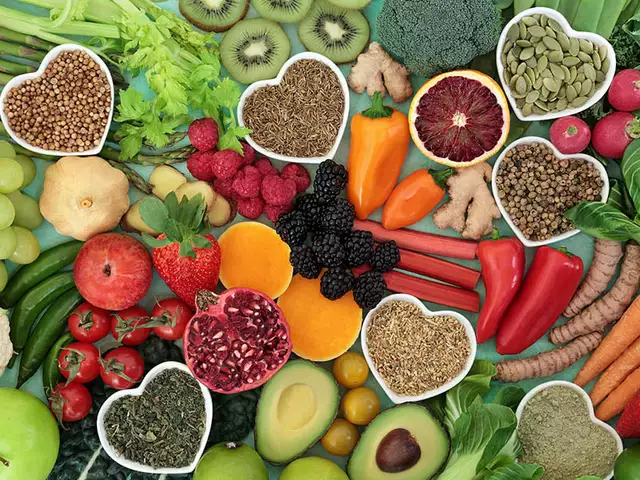
Alopecia Diet Nutrient Calculator
Your Nutrient Status
Enter your daily values and click "Check Your Nutrient Intake" to analyze your diet's impact on hair health.
Key Nutrients for Hair Health
Iron
Essential for oxygen transport to hair follicles. Low levels can cause diffuse shedding.
Zinc
Supports DNA synthesis and protein production in follicles. Deficiency causes weak hair.
Vitamin D
Modulates keratinocyte growth. Low levels linked to alopecia areata.
Biotin
Co-enzyme in fatty acid metabolism. Deficiency causes patchy hair loss.
Omega-3s
Reduces scalp inflammation and improves blood flow to follicles.
Selenium
Antioxidant that protects follicles from oxidative stress.
Ever wondered why some people see their hair thin out even though they’re eating "healthy" meals? The answer often lies in the alopecia diet you follow. Your plate can either starve your follicles or feed them back to life. Below we unpack the science, the must‑have nutrients, and the foods that truly matter for hair‑related conditions.
Quick Take
- Alopecia isn’t just genetics - diet supplies the building blocks hair needs.
- Iron, zinc, vitaminD, biotin, protein, omega‑3s and selenium are the top‑ranked nutrients.
- Whole‑food, low‑glycemic meals (think Mediterranean style) support scalp health.
- Processed snacks, excessive sugar and high‑glycemic carbs can trigger inflammation and worsen shedding.
- A sample 7‑day menu can be built with three balanced meals plus two nutrient‑rich snacks each day.
What Is Alopecia?
When you hear "alopecia," most people think of bald spots on the scalp. In reality the term covers several hair‑loss patterns, from androgenic alopecia - the common male‑or‑female pattern - to telogen effluvium, an abrupt shedding triggered by stress or hormonal shifts. The condition is essentially a disruption of the hair‑growth cycle, and nutrients act as the fuel that either corrects or deepens that disruption.
Why Nutrition Matters for Hair
Hair follicles are among the fastest‑growing cells in the body. To maintain that speed they need a steady supply of amino acids, minerals and vitamins. When your diet lacks any of these, the follicle switches from the growth (anagen) phase to the resting (telogen) phase, leading to visible thinning. Moreover, certain foods influence hormone levels and inflammation, both of which play a big role in alopecia triggers.
Key Nutrients That Impact Alopecia
Below are the eight powerhouse nutrients most often linked to hair‑loss prevention and regrowth. Each entry includes its primary function, the symptoms of deficiency, and the best food sources.
- Iron helps deliver oxygen to hair follicles; low iron can cause diffuse shedding. Sources: lean beef, lentils, spinach, pumpkin seeds.
- Zinc supports DNA and protein synthesis in the follicle; deficiency leads to weak, brittle strands. Sources: oysters, pumpkin seeds, chickpeas, quinoa.
- VitaminD modulates keratinocyte growth; low levels are associated with alopecia areata. Sources: fatty fish, fortified dairy, sunlight exposure.
- Biotin (VitaminB7) acts as a co‑enzyme in fatty‑acid metabolism; deficiency can cause patchy hair loss. Sources: eggs, almonds, sweet potatoes, nuts.
- Protein provides the amino acids that build keratin, the main protein of hair. Sources: chicken, tofu, Greek yogurt, beans.
- Omega‑3 fatty acids reduce scalp inflammation and improve blood flow; low intake may worsen shedding. Sources: salmon, walnuts, chia seeds, flaxseed oil.
- Selenium aids antioxidant enzymes protecting follicles from oxidative stress. Sources: Brazil nuts, tuna, brown rice, eggs.
- VitaminC enhances iron absorption and supports collagen, which anchors hair shafts. Sources: oranges, bell peppers, kiwi, broccoli.

Comparison: Nutrient Deficiency vs Hair Impact
| Nutrient | Common Deficiency Symptom | Hair‑Loss Connection |
|---|---|---|
| Iron | Fatigue, pale skin | Diffuse shedding, especially in women |
| Zinc | Impaired taste, frequent infections | Weak, slow‑growing hair; alopecia areata flare‑ups |
| VitaminD | Bone pain, mood swings | Increased risk of alopecia areata and telogen effluvium |
| Biotin | Skin rash, brittle nails | Patchy, thinned hair patches |
| Protein | Muscle loss, edema | Overall thinning, slower regrowth after shedding |
| Omega‑3 | Dry skin, joint stiffness | Scalp inflammation, reduced follicle blood supply |
| Selenium | Hair brittleness, fatigue | Oxidative damage to follicles, telogen shift |
Foods to Embrace: Building a Hair‑Friendly Plate
Think of your meals as a mini‑clinic for your scalp. The Mediterranean diet, rich in whole grains, lean proteins, nuts and leafy greens, consistently ranks high in studies on hair health. Here are the top food groups to include daily:
- Lean red meat & legumes: pack iron and zinc.
- Fatty fish (salmon, mackerel): deliver omega‑3s and vitaminD.
- Eggs & dairy (if tolerated): provide biotin, protein, and selenium.
- Colorful vegetables & fruits: boost vitaminC and antioxidants.
- Nuts & seeds (especially Brazil nuts and pumpkin seeds): hit the selenium and zinc sweet spot.
Foods to Limit: What Might Be Undermining Your Hair
Not every “healthy” label means hair‑friendly. Certain items increase inflammation or spike insulin, both of which can push follicles into the telogen phase.
- Highly processed carbs: white bread, sugary cereals, pastries - cause insulin spikes and raise androgen activity.
- Excessive dairy or soy (for those sensitive): may trigger an autoimmune response in alopecia areata patients.
- Alcohol & smoking: reduce nutrient absorption and impair blood flow to the scalp.
- Fast‑food trans fats: elevate systemic inflammation, worsening hair‑loss patterns.
Putting It All Together: A Sample 7‑Day Meal Plan
Below is a practical, nutrient‑dense menu that hits every key vitamin and mineral. Adjust portions to your caloric needs, but keep the balance of protein, healthy fats and low‑glycemic carbs.
- Day1: Breakfast - Greek yogurt with kiwi and chia seeds; Lunch - quinoa salad with spinach, chickpeas, and grilled salmon; Dinner - stir‑fry beef with broccoli, bell peppers, and brown rice.
- Day2: Breakfast - scrambled eggs with smoked turkey and sautéed kale; Snack - a handful of Brazil nuts; Lunch - lentil soup with carrots and whole‑grain toast; Dinner - baked cod with sweet potato mash and steamed asparagus.
- Day3: Breakfast - oatmeal topped with pumpkin seeds and berries; Lunch - chicken Caesar (use olive‑oil dressing, add extra avocado); Dinner - tofu curry with coconut milk, spinach, and basmati rice.
- Day4: Breakfast - smoothie (spinach, orange, whey protein, flaxseed); Snack - boiled egg + orange slice; Lunch - turkey wrap with whole‑wheat tortilla, hummus, and mixed greens; Dinner - grilled sardines, quinoa, and roasted zucchini.
- Day5: Breakfast - cottage cheese with sliced peach and almonds; Lunch - bean chili with kidney beans, bell peppers, and a side of cornbread; Dinner - pork tenderloin, sautéed kale, and baked carrots.
- Day6: Breakfast - avocado toast on sourdough with poached egg; Snack - mango cubes; Lunch - salmon sushi bowl (brown rice, avocado, cucumber, seaweed); Dinner - lentil‑based shepherd’s pie with cauliflower topping.
- Day7: Breakfast - protein pancakes (egg white, oat flour) topped with fresh strawberries; Lunch - grilled chicken salad with walnuts, arugula, and lemon‑olive oil dressing; Dinner - vegetable lasagna (use ricotta, spinach, zucchini).
Each day delivers at least 18mg of iron, 12mg of zinc, 600IU of vitaminD (or sufficient sunlight), 30µg of selenium, and 2g of omega‑3s - all proven to support robust hair growth.
Common Pitfalls & How to Avoid Them
- Relying on supplements alone: Whole foods provide synergistic cofactors that pills can’t replicate.
- Skipping meals: Prolonged fasting can drive the body into a stress response, pushing follicles into telogen.
- Ignoring thyroid health: An under‑active thyroid mimics iron deficiency; a simple TSH test can rule it out.
- Over‑scrubbing the scalp: Harsh shampoos strip natural oils, reducing the effectiveness of nutrients you’ve just eaten.
- Not staying hydrated: Dehydration reduces blood volume, limiting nutrient delivery to the scalp.

Frequently Asked Questions
Can a vegan diet prevent alopecia?
Yes, if you carefully plan protein, iron, zinc, and B‑vitamin sources. Lentils, tofu, quinoa, nuts and fortified plant milks can meet the needs, but you may need a B12 supplement.
How long does it take to see hair improvement after changing my diet?
Hair cycles take about three to six months. Most people notice reduced shedding after 8‑12 weeks, with visible regrowth after half a year of consistent nutrition.
Is it safe to take high‑dose biotin for hair loss?
Biotin is water‑soluble, but mega‑doses (10mg+) can interfere with lab tests. A 30‑100µg daily dose is generally sufficient when paired with a balanced diet.
Do I need to avoid gluten if I have alopecia areata?
Only if you have a diagnosed gluten sensitivity or celiac disease. Some small studies suggest a low‑gluten diet may reduce autoimmune activity, but evidence is not conclusive.
What role does the gut microbiome play in hair health?
A healthy gut improves nutrient absorption and curbs systemic inflammation. Probiotic‑rich foods like kefir, kimchi, and fermented soy can indirectly support hair growth.
14 Comments
Albert Gesierich
October 4, 2025 AT 02:35 AM
The article presents a solid overview, but it neglects to mention the recommended Dietary Reference Intakes (DRIs) for each nutrient, which are essential for accurate assessment. For instance, adult women require 18 mg of iron daily, not the vague "at least 18 mg" stated. Additionally, the claimed 600 IU of vitamin D is below the Endocrine Society's 1500 IU recommendation for deficiency correction. Precise values prevent misinterpretation.
Brad Tollefson
October 6, 2025 AT 10:08 AM
Looks like the calculator covers the basics, but I’d add that omega‑3s also help with scalp inflammation, which can exacerbate telogen effluvium. Pairing fatty fish with a leafy green salad maximizes both EPA/DHA and iron absorption thanks to vitamin C. Just a heads‑up for anyone tweaking the numbers.
Paul van de Runstraat
October 8, 2025 AT 17:42 PM
Nice rundown, but let’s be real-if you’re not already eating the Mediterranean way, you’ll probably need more than a dash of salmon. Still, it’s great that the post highlights zinc; without it, even the best hair products won’t help. I guess it’s a reminder that diet beats a pricey conditioner every time.
ashish ghone
October 11, 2025 AT 01:15 AM
Hey everyone! 😊 Let me break down why a holistic approach to nutrition matters for hair health, and trust me, this goes way beyond just ticking boxes on a calculator. First, protein provides the building blocks for keratin, the main structural component of each strand; without sufficient amino acids, follicles can’t sustain the anagen phase, leading to premature shedding. Second, iron’s role isn’t limited to oxygen transport-its deficiency prompts a cascade of hormonal imbalances that can trigger diffuse telogen effluvium, especially in pre‑menopausal women. Third, zinc acts as a co‑factor for over 300 enzymatic reactions, many of which regulate DNA synthesis and cell division, processes vital for follicle regeneration. Fourth, vitamin D receptors are expressed in dermal papilla cells, meaning this vitamin directly influences the hair‑growth cycle; low levels correlate with alopecia areata flares. Fifth, omega‑3 fatty acids (EPA and DHA) help resolve scalp inflammation, improve microcirculation, and even modulate prostaglandin pathways that affect hair cycling. Sixth, selenium’s antioxidant properties protect follicular cells from oxidative stress, a known trigger for premature catagen transition. Seventh, biotin, while often over‑hyped, truly supports fatty‑acid metabolism, which indirectly sustains the lipid‑rich environment of the scalp. Lastly, vitamin C isn’t just for immunity; it dramatically enhances non‑heme iron absorption, ensuring the iron you eat actually gets to your follicles.
Putting this all together, a balanced plate should include lean meats or legumes for iron and protein, nuts and seeds for zinc and selenium, fatty fish or algae for omega‑3s, and a colorful array of fruits and vegetables for vitamin C and assorted phytonutrients. Hydration plays a subtle but critical role too-adequate water maintains plasma volume, facilitating nutrient delivery to the scalp. And don't forget the timing: hair cycles are slow, so consistent dietary patterns over at least three to six months are needed before you see measurable regrowth.
In short, think of your meals as a daily prescription for your scalp; each bite fuels the follicles, and neglecting any one nutrient can derail the whole system. 🌿 Stay patient, stay consistent, and your hair will thank you!
steph carr
October 13, 2025 AT 08:48 AM
This is a solid starter guide-especially the part about whole‑food sources over isolated supplements. I’d add that rotating protein sources (fish, poultry, beans) can help avoid nutrient gaps. The Mediterranean pattern really shines for hair, thanks to its balanced fats and micronutrients.
Vera Barnwell
October 15, 2025 AT 16:22 PM
While the article is thorough, I can’t help but wonder if the mainstream nutrition guidelines are part of a larger scheme to keep us dependent on fortified foods. Think about it: they push you to buy expensive supplements while the real solution-soil health, organic farming, and a diversified diet-gets sidelined. Still, if you’re stuck with conventional produce, at least aim for varied colors; each hue brings its own set of antioxidants that could counteract hidden toxins in our water supply.
David Ross
October 17, 2025 AT 23:55 PM
Great points above!; particularly the emphasis on a balanced intake; it's essential not to over‑focus on a single nutrient-excess zinc can actually impede copper absorption, leading to other hair issues. ; Staying diverse is key.
Abby Elizabeth
October 20, 2025 AT 07:28 AM
Ugh, diet tips are so boring.
Mark Haycox
October 22, 2025 AT 15:02 PM
Honestly, this whole "eat more iron" nonsense is just another way for the food lobbies to push their fortified cereals. The real problem is the government's hidden agenda to keep citizens weak and dependent.
Michael Taylor
October 24, 2025 AT 22:35 PM
Really appreciate the comprehensive list-however, remember that consistency beats occasional superfood binges; it's the everyday choices that make the biggest impact on follicle health; also, keep an eye on your overall caloric intake so you don't unintentionally trigger stress‑related shedding; balance is everything.
Troy Brandt
October 27, 2025 AT 06:08 AM
I’m curious about the practical side of tracking these nutrients day‑to‑day. Have you tried any particular apps or journals that make it less of a chore? From my experience, integrating food logs with a simple spreadsheet can provide a clear visual of where you might be lacking, especially for micronutrients that are easy to overlook.
Barbra Wittman
October 29, 2025 AT 13:42 PM
Sure, spreadsheets work, but let’s be honest-most people won’t sustain that level of detail for more than a week, so the whole"track everything" premise feels a bit overblown. In reality, focusing on broad food groups-like ensuring a handful of nuts daily for zinc and selenium-delivers steady nutrient flow without the need for obsessive data entry; that’s the sweet spot between effort and results.
Gena Thornton
October 31, 2025 AT 21:15 PM
For anyone looking to optimize their intake, consider pairing iron‑rich foods with vitamin C sources at each meal; this boosts absorption dramatically and is a simple tweak that can make a noticeable difference over time.






Robert Frith
October 1, 2025 AT 19:02 PM
Oi mate, if you think a bit of kale and beans will fix everythin' for the British headscalp, you’re missin’ the point. Our diet needs proper iron and zinc, not just a sprinkle of fancy superfoods. And stop thinkin’ you can dodge the whole issue by drinkin’ a cuppa tea – you still need solid nutrients.